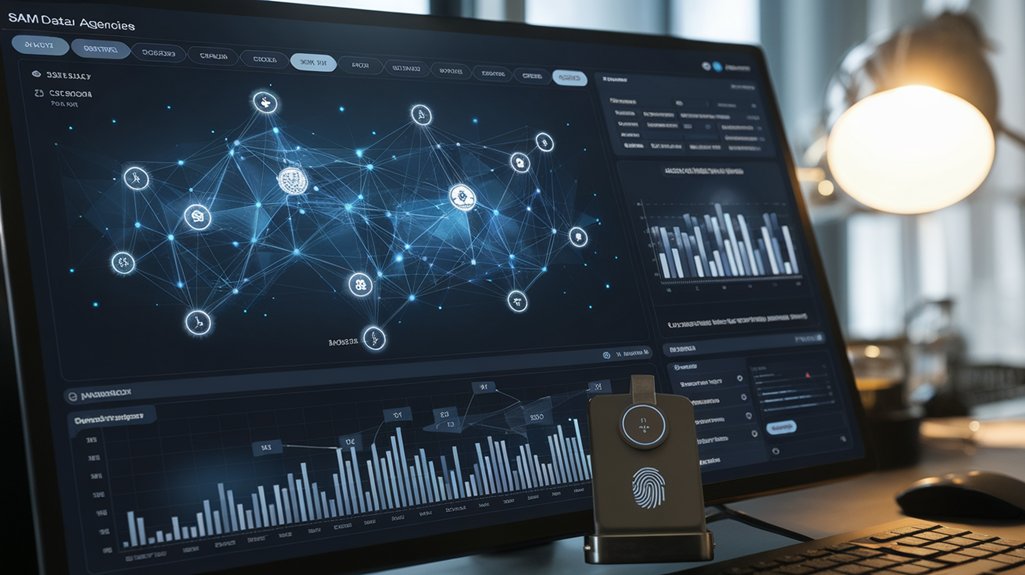SAM registration provides contractors with strategic advantages beyond contract eligibility. By analyzing SAM data reports, businesses can identify agency spending patterns, procurement frequencies, and upcoming opportunities aligned with their capabilities. Effective federal relationship building requires crafting targeted communication strategies based on agency priorities found in strategic plans and performance reports. Regular engagement through focus groups, communication audits, and interagency partnerships creates meaningful connections that extend beyond the registration process. The methods below expand these fundamental networking concepts into actionable strategies.
Establishing Your Federal Presence: SAM Registration and Beyond

Before any organization can begin conducting business with the federal government, registering in the System for Award Management (SAM) represents an essential first step. This registration establishes federal eligibility, providing entities with a Unique Entity ID that serves as their identifier across all federal systems.
The SAM registration process takes approximately 10 business days to complete and requires no fee. Once registered, organizations must maintain their active status through annual renewals every 12 months. Timely registration updates are vital whenever entity information changes. Organizations can access helpful Quick Start Guides on SAM.gov that provide step-by-step assistance throughout the registration process. The process includes obtaining a DUNS number first, which is necessary for completing the SAM registration properly.
Complete your SAM registration in 10 business days without fees, then maintain active status through annual renewals and timely updates.
Recent interim rule changes have clarified that while continuous SAM registration is no longer required throughout the entire contract evaluation process, organizations must have active registrations at both proposal submission and contract award phases. This adjustment relieves entities from potential disqualification due to brief registration lapses while maintaining necessary oversight standards. The new interim rule becomes effective November 12, 2024, benefiting contractors who previously faced harsh consequences for registration gaps.
Beyond contracting, SAM registration enables grant applications and facilitates streamlined information management across federal systems.
Leveraging SAM Data to Identify Key Agency Connections

With SAM registration established, organizations can extract valuable intelligence from the system’s extensive data repositories. Through targeted data analysis, companies can identify agencies with recurring needs that align with their capabilities.
Contract Data Reports reveal historical purchasing patterns, showing which agencies consistently procure specific services or products. Organizations should track spending trends by NAICS codes to pinpoint agency focus areas that match their offerings. Analyzing award frequency patterns identifies consistent buyers for strategic agency outreach initiatives.
For effective networking, companies should:
- Review Opportunity Forecasts to identify planned procurements
- Examine Entity Registration Data to understand current contractor landscapes
- Analyze Subcontracting Reports to uncover potential partnership opportunities
- Use SAM Data Extracts for bulk analysis of agency spending behaviors
These approaches transform raw SAM data into actionable intelligence, enabling businesses to forge meaningful connections with agencies most likely to require their services.
Businesses should also explore prime contracts structure to better understand requirements and position themselves strategically for subcontracting roles.
Strategic Communication Techniques for Agency Relationship Building

Effective communication serves as the cornerstone of successful relationships with federal agencies, requiring both strategic planning and tactical execution. Companies must analyze stakeholder priorities to deliver effective messaging that addresses agency-specific needs and aligns with their strategic objectives.
When engaging with federal partners, organizations should:
- Study agency strategic plans and performance reports to understand priorities
- Craft plain-language messages that reflect OMB Circular A-11 frameworks
- Develop tiered communication approaches for different stakeholder levels
- Utilize accessibility-compliant formats per Section 508 requirements
Stakeholder engagement improves when companies monitor agency social media channels and Federal Register notices to identify emerging priorities. Effective federal engagement should incorporate Donna Garland’s trust triangle principles that balance authenticity, logic, and empathy in all communications. Maintaining brand consistency across all communications with federal agencies builds trust and reinforces organizational credibility.
Establishing communication task forces with interagency partners creates valuable collaboration opportunities while implementing message testing through focus groups guarantees communications resonate with target audiences. Registration in the SAM database increases visibility with government agencies and opens doors to networking opportunities with other federal contractors.
For ongoing relationship maintenance, conduct quarterly communication audits and document outcomes with improvement plans to demonstrate commitment to partnership excellence.
Frequently Asked Questions
How Long Does SAM Registration Typically Take to Be Approved?
The SAM registration timeline typically spans 7-10 business days for approval, though the complete process can extend from 2-8 weeks depending on various factors.
External reviews may add up to ten additional business days, while recent system updates have caused more significant delays of up to 10 weeks for some organizations.
The approval process duration is influenced by preparation quality, documentation issues, and technical challenges.
Regular status checks are recommended to monitor progress throughout the registration process.
Can I Update My SAM Profile After Submission?
Yes, entities can update their SAM profile after submission at any time, not just during renewal periods.
When making submission updates, users must:
- Log in with the associated login.gov account
- Review all sections sequentially
- Save changes in each section before proceeding
This process allows businesses to modify information such as business details, addresses, points of contact, and certifications.
Regular updates guarantee the profile remains accurate and compliant with federal requirements.
How Often Should I Check for New Contract Opportunities?
Businesses should check for federal contract opportunities at varying frequencies based on procurement cycles.
During peak seasons, twice-weekly checks are recommended, while off-peak periods may require only weekly monitoring.
Setting up customized opportunity alerts through SAM.gov helps maintain awareness without constant manual searching.
Contractors should also review agency forecasts twice yearly and verify date-modified indicators to guarantee information timeliness.
Cross-referencing between SAM, FPDS, and USAspending provides extensive coverage of available opportunities.
Are There Agency-Specific Communication Protocols Not Listed on SAM?
Yes, many federal agencies maintain communication protocols that aren’t listed on SAM.gov.
These agency-specific protocols often include preferred contact methods, specialized forms, and unique documentation requirements.
Protocol differences exist because agencies have distinct operational needs and security requirements.
Vendors should regularly check agency websites, reach out to agency representatives directly, and attend industry events to learn about these specialized communication channels.
Understanding these unique requirements helps businesses better position themselves for successful government partnerships.
What Metrics Indicate Successful Relationship Building With Federal Agencies?
Successful federal agency relationship building can be measured through several key indicators.
Relationship longevity demonstrates sustained partnership value, while established feedback mechanisms guarantee continuous improvement.
Additional metrics include alignment with agency strategic goals, successful meeting frequency, funding allocations, and regulatory support indicators.
Stakeholder satisfaction measurements, conversion rates of preferred outcomes, and resource allocation efficiency also provide tangible evidence of effective government relationships.
Regular assessment of these metrics helps organizations refine their engagement strategies with federal entities.